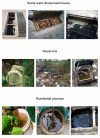Urban Mosquito Fauna in Mérida City, México: Immatures Collected from Containers and Storm-water Drains/Catch Basins
- PMID: 25429168
- PMCID: PMC4241551
- DOI: 10.3958/059.039.0207
Urban Mosquito Fauna in Mérida City, México: Immatures Collected from Containers and Storm-water Drains/Catch Basins
Abstract
We examined the species composition and temporal occurrence of immature mosquitoes in containers and storm-water drains/catch basins from November 2011 to June 2013 in Mérida City, México. A wide range of urban settings were examined, including residential premises, vacant lots, parking lots, and streets or sidewalks with storm-water drains/catch basins. In total, 111,776 specimens of 15 species were recorded. The most commonly collected species were Aedes (Stegomyia) aegypti (L.) (n = 60,961) and Culex quinquefasciatus Say (45,702), which together accounted for 95.4% of the immatures collected. These species were commonly encountered during both rainy and dry seasons, whereas most other mosquito species were collected primarily during the rainy season. Other species collected were Aedes (Howardina) cozumelensis Diaz Najera, Aedes (Ochlerotatus) taeniorhynchus (Wiedemann), Aedes (Ochlerotatus) trivittatus (Coquillett), Culex coronator Dyar and Knab, Culex interrogator Dyar and Knab, Culex lactator Dyar and Knab, Culex nigripalpus Theobald, Culex salinarius Coquillett, Culex tarsalis Coquillett, Culex thriambus Dyar, Haemagogus equinus Theobald, Limatus durhamii Theobald, and Toxorhynchites rutilus (Coquillett). The greatest number of species was recorded from vacant lots (n = 11), followed by storm-water drains/catch basins (nine) and residential premises (six). Our study demonstrated that the heterogeneous urban environment in Mérida City supports a wide range of mosquito species, many of which are nuisance biters of humans and/or capable of serving as vectors of pathogens affecting humans or domestic animals. We also briefly reviewed the medical importance of the encountered mosquito species.
Figures
References
-
- Carpenter SJ, LaCasse WJ. Mosquitoes of North America (North of Mexico) University of California Press; Berkeley, CA: 1955.
-
- Colwell RK. EstimateS: Statistical estimation of species richness and shared species from samples. 2014 Version 9.1.0. User’s guide and application published at: http//purl.oclc.org/estimates.
-
- Darsie RF, Jr, Ward RA. Identification and Geographical Distribution of the Mosquitoes of North America, North of Mexico. University Press of Florida; Gainesville, FL: 2005.
Grants and funding
LinkOut - more resources
Full Text Sources
Other Literature Sources

